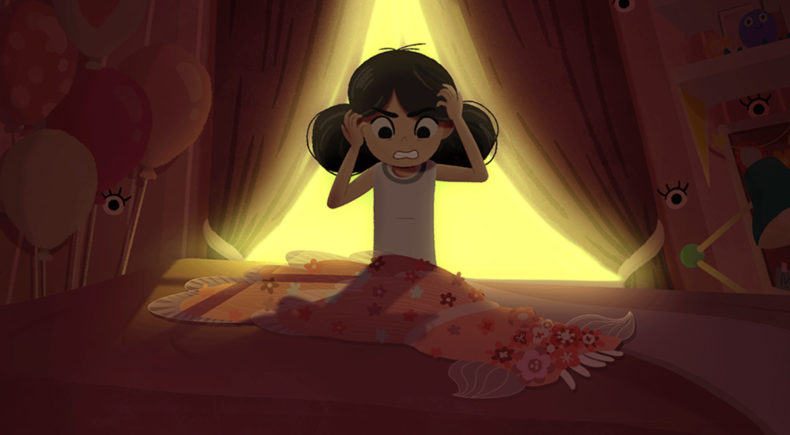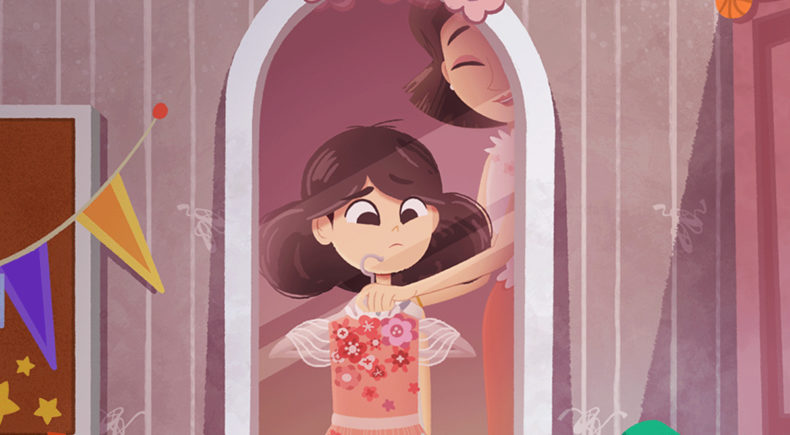A lot of parents want their child to be like them, and when they get to a certain age, they are excited to share their interests. What happens, though, when a child isn’t interested in something that gives their parents the same amount of joy? In Ana Gusson’s colorful, emotionally open animated short, Pivot, we see one mother decide to not respond with anger or confusion to her daughter’s reluctance. By following the cues of screenwriter Robyn Campbell’s compassionate script, this mother-daughter bond flourishes rather than flounders.
*We have linked the animated short film below. Take a look and then come back to read our interview!
Pivot shows how a seemingly small interaction can cause a youngster a mountain of stress. A mother suggests that daughter wears a dress to a party, but the daughter would rather spend her time in jeans. The frilly frock is pink and shares the same sized flowers that her mother is wearing on her blouse. It’s not that this young girl doesn’t want to be like her mother, but she has a different idea of what makes her feel good. When the dress becomes an unavoidable monster, the daughter must battle with it to retain her sense of self.
A lot of people will relate to Pivot when they think back to their childhood. My mother was never restrictive in what I wore or how I played, so she didn’t bat an eye when I wanted to dress as a fairy princess or Catwoman (Michelle Pfeiffer’s version, naturally). Campbell’s inspiration also came from a very personal place.
“The physical storyline, on the surface, is based off of a childhood friend of mine,” Campbell says at the start of our conversation. ” We met in preschool, and she absolutely hated wearing dresses so much. It was intense. Every picture day, birthday party, or Christmas concert, her mom would make her wear big, matching dresses with her sister. She would turn into a little feral cat when she got to school, and she would have these breakdowns with her mom. This friend has grown up to be an adult who only wears pants–it would be so strange if I ever saw her in a dress now. I was inspired by her story because it was so visceral and physical, but her emotional tale of that is that she has always been very strong. When she saw the film, she admitted that she shed a few tears.
“The emotional component is my own storyline and how I felt, growing up, a lot of shame. We grew up in a small city in Canada, and I was full of a lot of emotions. I wrote a lot of poetry at a young age. I didn’t know anyone that was gay when I was younger, and I was struggling with my bisexuality. I felt a lot of shame about it, and it didn’t help that in the ’90s people thought that you were either gay or that you were straight. I really hid myself from those that were closest to me for a very, very long time. It took me until my twenties to really come out and to also come out as someone who writes these emotional things. It took time to get over that fear. I really wrote this in an attempt to show younger people that you shouldn’t try to do everything to hide your true self. Tell the people around you who you are. No one else is going to do it for you.”
 I was surprised to learn that Campbell’s original script used dialogue while the final film is mostly silent. What’s most impressive is how expressive the characters are in how they relay tentativeness, fear, and happiness without the use of words, and Campbell expressed the desire to create a universal story that excels beyond the world of language. We can even take the situation and apply different circumstances but still hope for the same results.
I was surprised to learn that Campbell’s original script used dialogue while the final film is mostly silent. What’s most impressive is how expressive the characters are in how they relay tentativeness, fear, and happiness without the use of words, and Campbell expressed the desire to create a universal story that excels beyond the world of language. We can even take the situation and apply different circumstances but still hope for the same results.
“I originally wrote it to have dialogue, and it was chosen to be produced with words,” she said. “One of my mentors, Julie Stewart, immediately suggested that we remove it. She liked the dialogue, but she pointed out that this is a story that resonates all over the world. It’s not a story tied to a specific culture. Anyone in any language should be able to understand it–it reaches a more worldwide audience that way. We have been in festivals in Korea, Germany, and Italy, and it has connected with so many people in different ways. It was the right choice. It took some time to take all of that dialogue and translate it into actions or looks on someone’s faces in order to replace that, but it was a great practice for me as a writer. In general, I think less dialogue is better. If you can change conversation into a look, you’ve nailed it. You can improve your script that way.”
The monster itself is rather gnarly, and it looms over this young girl with a heaving, threatening presence. With its pointy teeth and its layered rose color, it resembles a succubus straight out of Barbie Land. Campbell’s image of this monster came from a really dark place.
“In my mind, it was mostly darkness,” she says. “The monster is a representation of negative feelings. Of fear, shame, and guilt of who we are. All those feelings of shame and guilt are judgements of ourselves. I’ve learned to imagine those feelings inside of my body and I visualize them around me. Fear, for me, is a dark cloud that can surround me. I imagine the size of it and the color of it, and I like to think of it shrinking smaller and smaller until it, eventually, dissipates. How I processed my feelings was how I wanted to show the dress transforming into this monster. Something that is very internal to me became something very visual. What would happen in her imagination of overcoming and processing fear and guilt about herself is the translation that you see. When you’re fighting it or attacking it is about you resisting it being inside you. You rejecting it won’t make it go away–it’ll consume you. It overtakes her the more she fights it.”
Another important aspect of Pivot is how they don’t demonize this mother’s wants either. Even if her daughter doesn’t want to sport pink, that doesn’t mean the mom will stop any time soon. And, who knows? Maybe her daughter’s strength and determination will allow her mother to explore outside her comfort zone.
 “It was important to us that the mother isn’t a villain–she’s not a bad mom,” Campbell says. “She just doesn’t see her daughter, because she is caught up in remembering what she wanted when she was young. I think a lot of parents want their kids to be like them, and it can be anything from a dad being psyched up for his son to play football to a mother wanting to relate to her daughter once she has kids. What’s so much more powerful for their mental health is to take interest over their interest. Don’t try to push your interests on them.”
“It was important to us that the mother isn’t a villain–she’s not a bad mom,” Campbell says. “She just doesn’t see her daughter, because she is caught up in remembering what she wanted when she was young. I think a lot of parents want their kids to be like them, and it can be anything from a dad being psyched up for his son to play football to a mother wanting to relate to her daughter once she has kids. What’s so much more powerful for their mental health is to take interest over their interest. Don’t try to push your interests on them.”
This short film has been playing all around the world, and people are talking excitedly about it. Campbell has experienced her share of reactions, and she told me about one special one that opened her eyes to how much of an impact this film is having.
“I [spoke to] a judge from a festival where the film has played, and he has two daughters,” she said, with a smile. “We ran into each other later, and he told me that watching it made him realize that he was pushing his opinions on his daughters in a way that he would never push on his friends or other family members. It’s not about just clothes but also about his morals and the way that he thinks. He thought that he was doing it for a good reason, but he realized that he wasn’t listening to his daughters. If his daughters see a different side of their father because of watching this film, I will be very happy.”
https://www.youtube.com/watch?v=rJu0xRbNOXo





![2025 Oscars: Can a Late-Breaker Still Win Best Picture? [POLL]](https://www.awardsdaily.com/wp-content/uploads/2024/10/gladiator-350x250.jpg)
